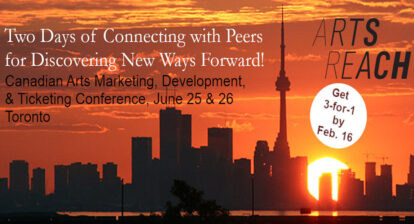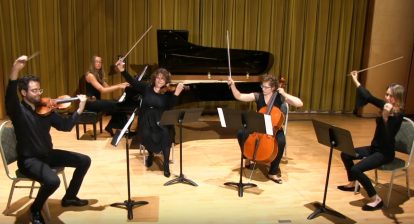June 7, 2019 – According to Canadian audience research, the social aspects of a live performance experience can both encourage and hinder attendance. Here’s a recap of a recent web conference during which facilitator and participants sought to make meaning of this social paradox.
The Social Conundrum of Arts Participation was held on May 9th. It brought together 29 participants in a discussion facilitated by Bridget MacIntosh and hosted by CAPACOA. The gathering was meant both as a sequel to an earlier discussion on Arts and Belonging and as an opportunity to explore findings from a recent report on Diversity and Drivers of Arts Attendance.
In all five audience research reports explored over the course of the web conference, social aspects stood out as a very common motivator for Canadians. Regardless of the source, between 20 to 60 % of Canadian reported that spending time with friends and family is one their reasons for attending the performing arts.
At the same time, having no one to go with can be a significant obstacle for certain attendees. In Culture Track Canada, 19% of respondents reported that “I couldn’t find anyone to go with” was an obstacle to their cultural participation. Interestingly, this obstacle is reported by both occasional and regular attendees.
This motivator/obstacle paradox is well summed up in a participant’s comment from a focus group study: “I like going in a group and it is rare that I will go alone. I like to share the moment with others.”
Such findings tend to confirm the hypothesis that the live performance is a fundamentally social experience. But they also beg the question: “How can the live performance be both an exciting social experience for group attendees and be a pleasant, non-intimidating experience for solo attendees?”
The Diversity and Drivers of Arts Attendance report thankfully provided a more nuanced overview of the social experience paradigm. After an analysis of motivators and frequency of attendance, the report revealed that “being able to go by myself” is a significant motivator for 45% of Canadians and it is closely associated with frequent attendance (monthly or more). “socializing with friends and family”, on the other hand, isn’t particularly associated with frequent attendance.
In other words:
- There are people for whom attending with friends is an important motivation, but these people aren’t necessarily the ones who attend most frequently;
- There are some people who may not attend if they can’t find anyone to go with, and this could be an obstacle to more regular attendance;
- Then there are certain people who do feel comfortable attending on their own and these people tend to be frequent attendees.
In addition, the Diversity and Drivers report also revealed that, of all motivators, “feeling welcome” is the most closely correlated with frequent attendance. This “feeling welcome” driver offers a way out of the social paradigm and provides a very potent path forward. Any action meant at making people feel more welcome is likely to have a positive impact on all types of art goers, regardless of their social motivations, perceptions or attitudes: groups of patrons will enjoy any added social dimension; patrons with no one to go with will come out with a warm feeling – and they might feel encouraged to overcome this barrier more often; and those who already feel comfortable going on their own will feel comforted in their behaviour and they will be favorably disposed to come back soon to a place where they enjoyed both great art and a feeling of being welcome.
Considering that the “feeling welcome” motivator is particularly important for allophones and immigrants, Bridget MacIntosh asked participants in the web conference: “How can we ensure that immigrants feel welcome and that immigrants continue to attend regularly?” Here are a few responses shared by participants:
- Building trust with local immigrant communities, and giving these communities opportunities to host or present their own events is important.
- Arts organizations can partner with settlement agencies to offer discounted or free attendance to recent immigrants. For example, in London, recent immigrants (first 5 years) can get passes for up to 4 people for 1 year.
- Canoo (formerly known as the Cultural Access Pass program), at the Institute for Canadian Citizenship, provides immigrants free access to cultural venues and events during their first year of citizenship.
- Relaxed performances are a good way to welcome certain patrons who might otherwise not attend regular performances.
- A patron’s first interaction is usually with box office and front-of-house staff. Are we doing everything that we can as a venue operators to hire staff that can serve patrons in multiple languages? Are we valuing and retaining them? Do we train them and inform them of everything that is going on in the venue? Do we provide them with the appropriate tools, skills and work environment to amplify the experience of feeling welcome?
Over the course of the web conference, Bridget MacIntosh also explored recent demographic trends about people living alone and the aging population. This led her to raise further questions: “Could it be that “going alone” is just an early attendance trend, and that more and more Canadians will attend alone in coming years?”, and “How can our sector respond and adapt to this trend?” These questions once again generated interesting observations and suggestions from web conference participants:
- Many older patrons – active seniors, many who live alone – like to be involved in group activities including a lot of volunteering.
- Get the word out to retirement homes: they often have bus trip to events.
- Matinees are more and more popular.
- One organization offers a ride to their venue – targeting specifically people who would not normally attend. A volunteer goes to each of their homes, greets them, helps introduce to others on the shuttle and guide them into the theatre, and greets them after the show to take them home.
- Secondary experience is also a huge part of it: facilitating time before or after for people to connect. These can include pre- and post-show discussions (with or without the artists) or social activities for volunteers.
- Creating “family” atmosphere for those attending event is very important.
- One organization tried singles nights, but they did not really work. These events brought together participants with mixed motivations: some attended primarily to meet someone, others were looking for a simple social outing, and others were there primarily for the art form.
- Many facilities have a coffee shop or some concession that they are operating outside of performance hours to create a space for community members to meet. Whereas a place like the Theatre Centre has been successful with approach, one organization reported trying to operate a patio and finding that people were more inclined to go to a local business.
The web conference format did unfortunately not allow for detailed explorations of these different ideas and suggestions. Conference organizers are encouraged to use the above research findings to spark their own dialogues on the notions of socialization, feeling welcome or sense of belonging.
For more information about this web conference or about CAPACOA’s research and professional development activities, please contact Frédéric Julien, Director of Research and Development.
Sources
EKOS Research Associates, Survey of the General Public, 2012
Environics Research, Arts and Heritage Access and Availability Survey 2016-2017
Corporate Research Associates, Focus groups on Canadians’ participation in the arts, 2018
LaPlaca Cohen and Nanos Research, Culture Track Canada, 2018
Nanos Research, Diversity and Drivers of Arts Participation, 2019
Recent and Related News
Tourism, Festivals and Live Performances: Facts, Trends and Opportunities
Living Solo / Being Social – Social Aspects of Arts Participation




